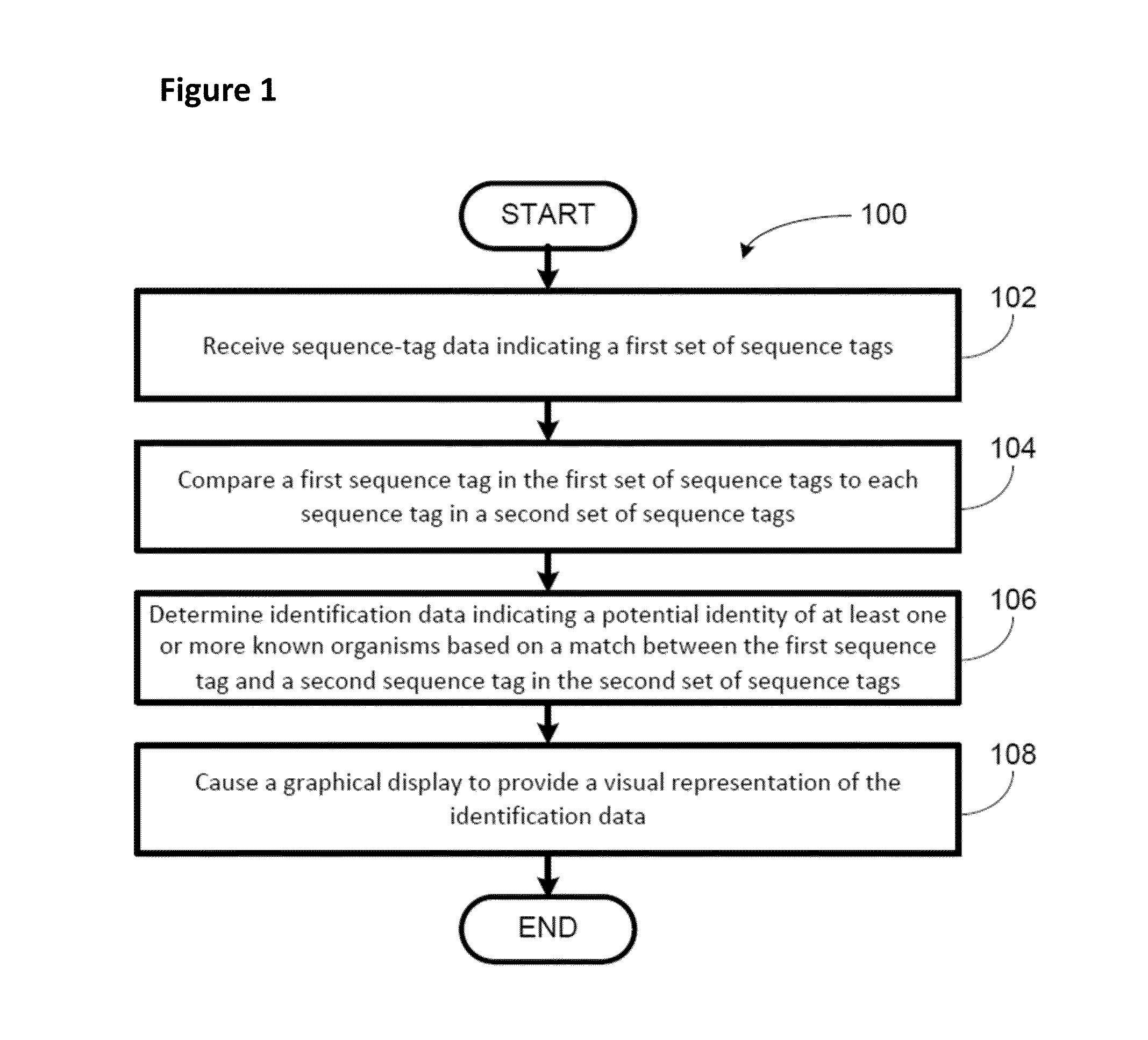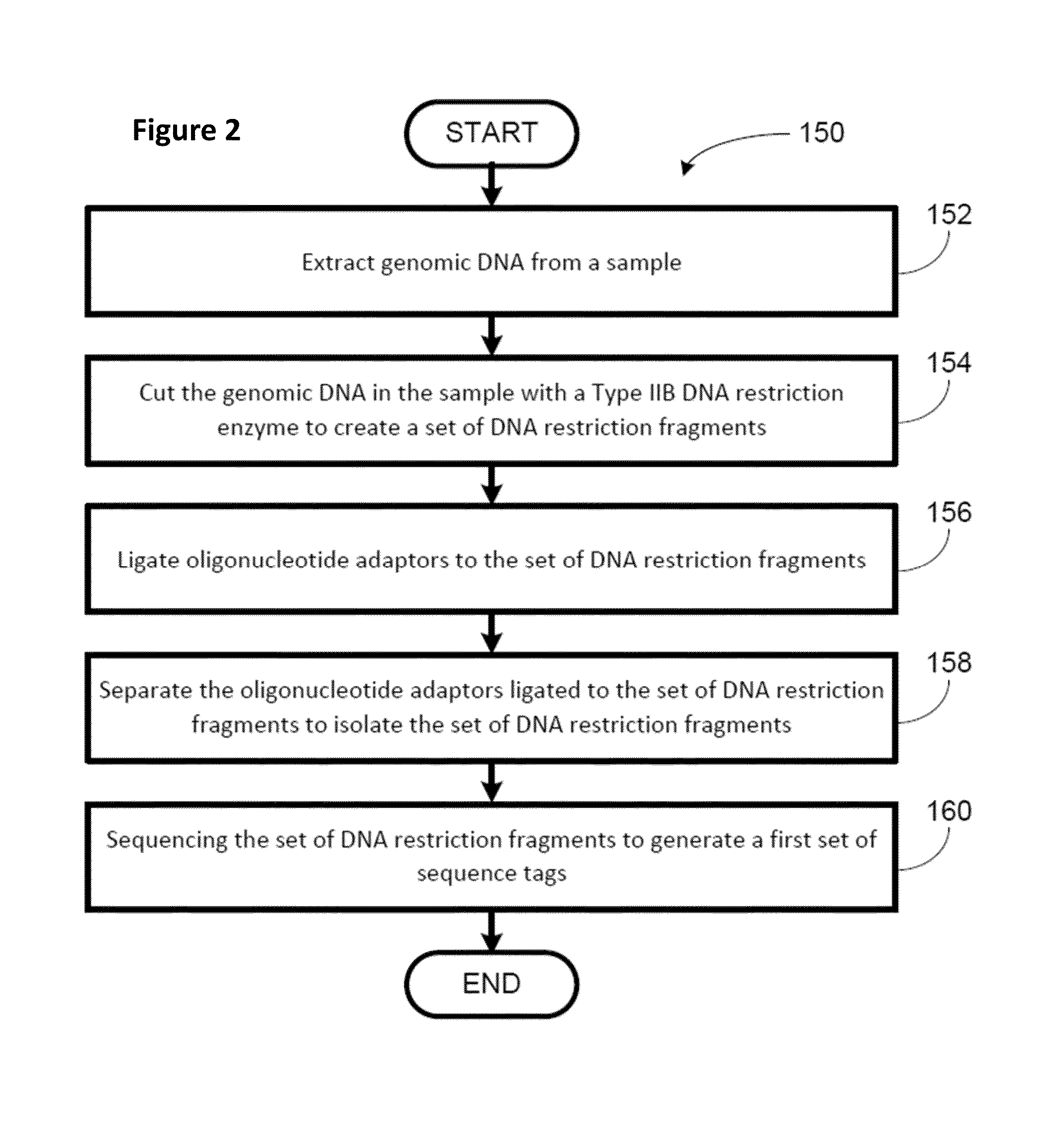High throughput digital karyotyping for biome characterization
a biome and high throughput technology, applied in the field of identifying dna sequences, can solve the problems of computational intensiveness, inability to adapt to viruses, phages, parasites,
- Summary
- Abstract
- Description
- Claims
- Application Information
AI Technical Summary
Benefits of technology
Problems solved by technology
Method used
Image
Examples
example 1
Application to Digital Karyotyping
[0098]The digital karyotyping capabilities of the method of the invention were initially characterized by analyzing the digital karyotype of an aseptically acquired human blood sample. Starting from 3 ug of genomic DNA, a total of 12,529,752 tags were identified from the human blood sample. Of these, 11,844,721 (95%) were perfect matches to tags in the human database. Of the 324,592 non-matching distinct tags, 44,785 were found in other aseptically-obtained human blood or human cell line samples, suggesting these are polymorphic or undocumented human sequences. An additional 199,016 tags were within 3 Levenshtein edit distances of nearest human match, again suggesting either polymorphic human sequence or amplification or sequencing error. Thus able 99.36% of tags from the human blood sample were assigned to human origin. The origin of the remaining tags was not known but may represent additional, individual polymorphism as has recently been describe...
example 2
Application to Linearly Amplified DNA
[0101]To demonstrate that the methods of the invention could be used effectively with small amounts of DNA amplified by linear, multiple displacement (phi29) amplification, 1 ng of the blood-derived human genomic DNA was amplified to yield 1 ug of total material. 4,091,327 tags were recovered from amplified material, of which 3,868,735 (95%) were perfect matches for human sequence (Table 2). 50.0% of all human tags were recovered. Comparison of the human karyotype of amplified an unamplified DNA demonstrated a high degree of linearity of the amplified material, although tag recovery was not as perfectly linear as with unamplified material (FIG. 8). Regression analysis revealed very high correlation coefficients for observed vs. expected tag counts per chromosome (r2=0.976 for amplified material). The distribution of recovered single copy tags did not reveal significant skewing relative to analysis of non-amplified material (FIG. 10). Karyotype an...
example 3
Application to Biome Characterization
[0102]The sensitivity of the methods of the invention for detection of non-human DNA was tested by spiking a human blood sample with purified E. coli genomic DNA. 1 ug of human blood DNA was combined with 20 pg of E. coli DNA (1:50,000 by weight, ˜1% by molar genome). As this sample was analyzed in multiplex (using a 2 bp barcode embedded in the adaptor), fewer total tags were recovered. Of the 681,325 tags recovered, 2,104 (0.3%) were found to be perfect matches for E. coli. Four hundred sixty four of the 988 potential distinct E. coli sequence tags were recovered. No other tags meeting criteria for any other microbial genome were identified.
[0103]The biome of the oral mucosa was identified and characterized using the methods of the invention to determine its ability to identify the organisms found in a complex host microbial environment. DNA was obtained from buccal brushings of two individuals and amplified with phi29 methodology. The first sa...
PUM
| Property | Measurement | Unit |
|---|---|---|
| Length | aaaaa | aaaaa |
| Distance | aaaaa | aaaaa |
| Nucleic acid structure | aaaaa | aaaaa |
Abstract
Description
Claims
Application Information
 Login to View More
Login to View More - R&D
- Intellectual Property
- Life Sciences
- Materials
- Tech Scout
- Unparalleled Data Quality
- Higher Quality Content
- 60% Fewer Hallucinations
Browse by: Latest US Patents, China's latest patents, Technical Efficacy Thesaurus, Application Domain, Technology Topic, Popular Technical Reports.
© 2025 PatSnap. All rights reserved.Legal|Privacy policy|Modern Slavery Act Transparency Statement|Sitemap|About US| Contact US: help@patsnap.com



